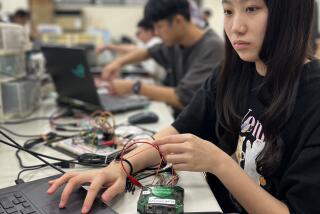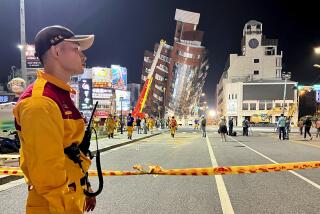Slump Gives Trio-Tech Most Severe Testing Yet
A. Charles Wilson, president of Trio-Tech International, walks into his office in San Fernando and finds an envelope on his desk. He picks up the envelope, shows it to a visitor, and says, “See, things aren’t so bad, I got paid this week.”
Things aren’t so good at Trio-Tech. The company makes testing equipment for the semiconductor industry, and the industry’s severe slump in the past three years dragged Trio-Tech down with it.
But Wilson’s quip about his paycheck underlines his belief that Trio-Tech’s prospects are improving. Some recent statistics indicate that a rebound is coming in the semiconductor business.
“I think we’ll be profitable in our quarter ending in December,” Wilson said.
This is not another high-tech start-up company going through its first whipsawing by unexpected market forces. Trio-Tech opened its doors in 1956, starting out as an electronics dealer before getting into the testing field.
Founder Is Chairman
Its founder, John C. Guy, 61, remains chairman of Trio-Tech and its biggest stockholder, with a 25% stake. Wilson, 63, was named president and chief executive in 1981 and has been a Trio-Tech director for 21 years. They already had pulled Trio-Tech out of one near-disaster in 1981. But, their experience wasn’t enough to shield Trio-Tech from losses in the latest slump.
Trio-Tech has plenty of company, of course. Big semiconductor makers, including Intel, Advanced Micro Devices and Texas Instruments, together lost hundreds of millions of dollars in 1985-86.
Some semiconductor-related firms did not survive at all. Six weeks ago, for example, GenRad closed its semiconductor-testing division in Milpitas, Calif., because of continued losses.
Before this slump, Trio-Tech was flourishing. In its fiscal year ended June 29, 1984, the company earned $2.2 million on sales of $12.8 million, and the next year net income rose to $2.8 million, a healthy 13% profit margin on record sales of $22 million.
Semiconductors are the fingernail-size electronic chips that power computers. Trio-Tech’s semiconductor equipment tests a chip’s durability and reliability.
Trio-Tech offers three main products--ranging in price from $30,000 to $150,000--that are geared to test specialized chips encased in hermetic, or airtight, seals.
One product tests a seal for leaks by submerging it in a fluid or trying to shoot gas through it; another is a “burn-in” device that subjects the chip to extreme temperatures, and the third is a centrifuge that puts tremendous pressure on the chip by spinning it at high speeds.
The company’s 600 customers include most of the major semiconductor makers, as well as big technology companies such as Rockwell, TRW, RCA and AT&T;, which test chips before installing them in their products.
But the big customer list didn’t help when the slump came. Trio-Tech lost $541,000 in fiscal 1986, and it is doing even worse this year, losing $828,000 in the nine months ended March 27 on sales of $11.3 million.
Work Force Pared
The company pared its work force by 30% to 300 people, and merged its office and manufacturing facilities--formerly in separate sites in Burbank--into a single plant in San Fernando.
Trio-Tech also tried last year to diversify away from semiconductors, but Trio-Tech’s stock collapse killed the deal.
Trio-Tech announced plans to buy MQS Inspection, a profitable metal-testing concern, for $14 million. It planned to raise the money from institutional investors by selling them debt convertible into Trio-Tech common stock. But as Trio-Tech’s losses mounted, its stock fell. And the institutional investors didn’t want to buy the debt because they didn’t want to end up owning the stock. Trio-Tech then considered borrowing from banks, but the terms were too costly. So it called off the deal.
Trio-Tech’s stock went public at $6.50 a share in December, 1984, climbed to a high of $17.75 in early 1985, and then crashed. It finished 1986 at $2.38 a share, and last week was trading at $2 a share over the counter.
Trio-Tech doesn’t appear to be in any immediate financial danger. Its current assets (cash and receivables due within the year) outpace its current liabilities (bills due within a year) by a 1.3-to-1 ratio, and the company has about $2 million available on a $5.7-million line of credit with Sanwa Bank.
Given the short history of the electronics business, Trio-Tech ranks as one of its pioneers. When the company was founded 31 years ago by Guy, it was called Tech Ser, and it sold transistors, tubes and other electric components. In 1966, it bought a company called Trio-Tech, a small maker of industrial centrifuges, and adopted the name.
In the late 1960s, with the semiconductor boom under way, Trio-Tech began building centrifuges designed specifically for testing semiconductors. Until then, chip testing was done on reconfigured medical
or industrial centrifuges, Wilson said.
By 1981, Guy was semi-retired, and Trio-Tech’s president was William B. Anhalt. The company considered itself profitable enough to sell its stock to the public for the first time. In preparation, Trio-Tech opened its books to an outside auditor and was shocked to discover it was actually losing money.
“The books that had been shown to the board of directors were far different from the books as eventually shown by the certified audit,” recalled Wilson. “Spending was out of control, and there was poor management that the board was not aware of.”
Anhalt resigned, and Trio-Tech’s board asked Wilson to step in as president. A corporate lawyer by training, Wilson also had been president of Daico Industries, an electronic-components maker in Compton, in the early 1970s.
After Trio-Tech lost $2 million in fiscal 1981-82, Wilson helped push the firm back into profitability the following two years, enabling the company to finally go public.
By then, worldwide demand for chips began drying up because of overproduction and lower-than-expected sales of personal computers.
Healthy Ratio
These days, Wilson is keeping his eye on a much-studied gauge of the industry’s health, the “book-to-bill ratio” compiled by the Semiconductor Industry Assn., a Cupertino trade group. In April, 1984, the ratio climbed to 1.69, meaning that for every $100 of chips shipped, the manufacturers received $169 of new orders. A ratio above 1.0 usually means that the industry is fit.
By the end of 1984, however, the ratio had plummeted to 0.64, and it wasn’t until this year that the ratio climbed above 1.0 and stayed there. In July, it stood at 1.15.
Wilson believes that chip makers are set to order more testing products, and based on past cycles, those orders usually come in six months to a year after business has turned up. If so, those orders should start arriving at Trio-Tech over the next few months.
Two chip makers and previous Trio-Tech customers, Advanced Micro Devices in Sunnyvale and National Semiconductor in Santa Clara, confirmed that they were placing new orders for testing products, but declined to specify whom they were buying from.
But G. Dan Hutcheson, president of VLSI Research, an industry consulting firm in San Jose, said he doubted there would be a surge in testing equipment. “This time people simply aren’t buying” testing products, he said, because of fears that the current improvement in semiconductor demand will be short-lived.
Given the price of Trio-Tech’s stock, investors also have their doubts.
“My job isn’t to make the stock move. My job is to make the company profitable, and when it’s profitable, the stock will go up,” Wilson said.
Not that Wilson needs any incentive to make Trio-Tech profitable. His 270,000 shares, or 10% of Trio-Tech’s stock, is only worth $600,000, down from $5 million in 1985.







